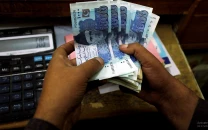Debt servicing may consume Rs7.6tr
90% more than this fiscal year’s original budget set aside for interest payments

Pakistan’s debt servicing cost may cross well over Rs7.6 trillion in the next fiscal year, which is roughly 15% more than the projected net income of the federal government but is still lower than the estimates made by the International Monetary Fund (IMF).
Sources in the Ministry of Finance told The Express Tribune that based on the fact that the federal government debt stood at Rs54.4 trillion at the end of March, interest payments in the next fiscal year may cross well over Rs7.6 trillion. However, a few officials have suggested showing the cost at around Rs6.9 trillion in the budget books aimed at having some additional fiscal space for spending in an election year.
The estimated Rs7.6 trillion debt servicing cost is 90% more than this fiscal year’s original budget set aside for interest payments and one-third higher than the revised estimates. It seems that taxes will be collected to just pay the cost of interest to domestic and foreign banks.
There were also differences of opinion between the Ministry of Finance and the Federal Board of Revenue (FBR) on next year’s tax target. Against the finance ministry’s proposed figure of Rs9.2 trillion, the FBR on Saturday suggested the government fix the target to around Rs8.6 trillion – only 19% higher than this year’s now expected collection.
For the next fiscal year, the government sees average inflation remaining at around 21% – any target below this rate will not bode well for the performance of the FBR.
Ballooned by record high inflation, the size of Pakistan’s economy is projected to increase to Rs106 trillion in FY2023-24, according to some initial estimates from the Ministry of Finance. These numbers are provisional and are subject to any changes made before the presentation of the budget in the National Assembly.
The estimates of Rs7.6 trillion debt servicing cost have been worked out on the basis of the debt stock of the country and to finance an under-consideration federal budget deficit of Rs6.8 trillion. Initial estimates show that even on the basis of the Rs9.2 trillion tax targets, the federal budget deficit could be in the range of 6.4% of the Gross Domestic Product (GDP) during FY2023-24, according to the sources.
Such a high cost of debt servicing leaves nothing in the kitty and any new government will literally be at the mercy of domestic and foreign lenders to run the country in the next fiscal year.
Nearly two-third of the domestic debt is maturing next year and will be financed at new interest rates. The projected interest payments amount is Rs3.6 trillion or 90% more than the original budget for the current fiscal year.
However, after an increase in the interest rates to 21%, the finance ministry later on revised the cost estimates to Rs5.2 trillion for this fiscal year.
Sources say that the IMF has estimated the interest cost to be around Rs8.2 trillion – Rs600 billion higher than the government’s estimates. This suggests that the IMF sees a further hike in interest rates and devaluation of the currency.
Some officials in the Ministry of Finance are advising to show only Rs6.8 trillion to Rs6.9 trillion in debt servicing costs aimed at having some fiscal space for spending ahead of general elections. Any such reflection in the budget will make the whole process unrealistic and the actual debt servicing cost and the overall budget deficit will be understated.
For the next fiscal year, the finance ministry sees the federal budget deficit – the gap between its income and expenditure – at 6.4% of the GDP or nearly Rs6.8 trillion. Any federal budget deficit target that is above 3.5% of the GDP is considered fiscally unsustainable.
The sources added that for the next fiscal year, the government expects to set the FBR’s tax target at Rs9.2 trillion. The non-tax collection target could be around Rs2.5 trillion. The government hopes to get Rs900 billion in profit from the State Bank of Pakistan and another Rs780 billion on account of petroleum development levy.
After paying for the share of the provinces in the federal taxes, the net federal income is estimated at around Rs6.6 trillion – at least Rs1 trillion less than the requirements of debt servicing.
The government will then meet all the requirements by taking new loans; these expenses will include requirements of defence, estimated over Rs2.5 trillion including the Rs1.7 trillion stated defence budget, running of the civil government, the development budget and subsidies.
The federal budget deficit widened by over Rs3.5 trillion in the first nine months of the current fiscal year on the back of a massive surge in spending on debt servicing and defence – both of which consumed two-thirds of the total expenditure, the Ministry of Finance reported last Friday. The federal government paid Rs3.6 trillion in debt servicing in nine months.
Published in The Express Tribune, May 14th, 2023.
Like Business on Facebook, follow @TribuneBiz on Twitter to stay informed and join in the conversation.

1728020501-0/Express-Tribune-Web-(13)1728020501-0-208x130.webp)

















COMMENTS
Comments are moderated and generally will be posted if they are on-topic and not abusive.
For more information, please see our Comments FAQ